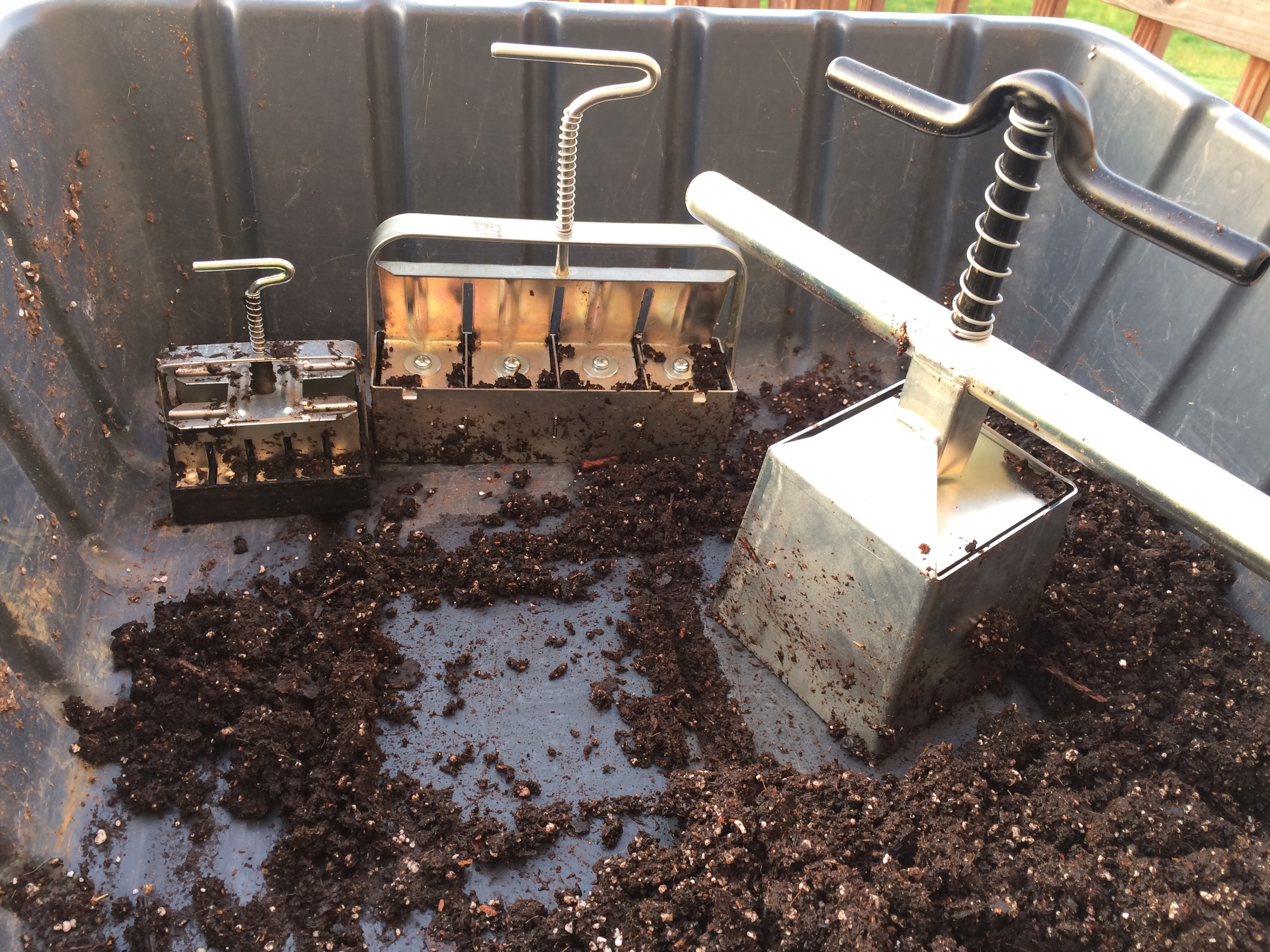Soil blocking is a method of starting and transplanting seedlings that minimizes root system disturbance. Soil blocks are made by compressing soil into small cubes that are able to hold together without any sort of container. Seeds can be started in small blocks then easily inserted into progressively larger blocks until they are ready to go directly into the ground.
There are some distinct advantages of using soil blocking techniques, rather than planting in peat pots or using plastic packs and trays. The first advantage is reduced cost—you will not have to purchase peat pots and plastic planting trays in varying sizes every year. You also won’t have to figure out how to store or dispose of them. The second advantage is the way that your plant’s root system will develop—they will be better than if your seeds are planted in containers. When plants are grown in containers the roots reach the edge of the container and they begin to circle to continue growing and can become root bound. When grown in soil blocks the roots do not circle the edge, they are “air pruned” at the edge of the block. Air pruning simply means that the initial roots slightly dry out and stop outward growth, which spurs secondary root development. The overall result is a well-developed, full root system for your plant. The final advantage is that during transplanting the entire root system and soil block are immersed into the ground—which means the root system is not disturbed by trying to remove it from a container. This results in a seamless transition for the roots and facilitates uninterrupted plant growth.
Recently we have received multiple inquiries about how to use Fertrell’s Premium Potting Soil for soil blocking. Our Premium Potting Soil blend is designed to aid in vigorous germination of seeds and it contains enough nutrients to grow your plants to a transplantable size, so it is a good choice for this purpose. Additionally, it contains aragonite, a coral and sea shell blend of available calcium, which encourages better utilization of nutrients than typical rock lime. Another benefit is its excellent water retention ability. I have completed some experimentation and have concluded that Fertrell’s Premium Potting Soil can successfully be used to make soil blocks for starting seeds, but some specialized tools are required. Soil block makers will need to be purchased in various sizes. The ones I used in my process included ¾” mini block makers for starting seeds, 2” ones that can be used for starting or transplanting the ¾” blocks, and 4” block makers for transplanting seedlings from the 2” blocks.
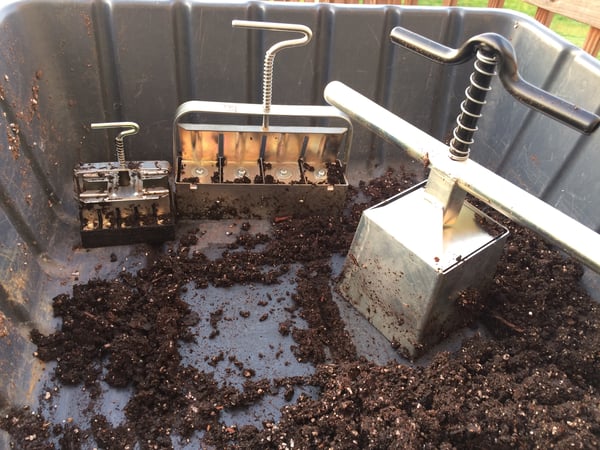
Soil blocking tools shown in ¾”, 2” and 4” sizes.
To begin with, I emptied the Fertrell Premium Potting Soil into a mixing tub. This soil mix contains particulates of varying sizes. If you are starting seeds in ¾” mini soil blocks you should begin by removing the largest of these particles, to allow for the best possible soil compaction. This could be done by screening the soil, but I just picked out the largest pieces by hand. Once this step is complete, add water to the soil. The soil should be damper than you may expect, about the consistency of a thick oatmeal.
Now you are ready to create the blocks. Start with soil piled twice as high as the block you are making, then push the block maker down into the soil, filling the mold. You need to apply steady pressure to compact the soil. Once the block is full, press it into the bottom of the tub and slide it back and forth to help pack the soil and scrape off the excess. On the ¾” blocks, you can actually flip the block maker over and use a thumb to press the soil in. You can also remove any large particles by hand. To remove the soil block from the mold, sit the block maker on the flat surface where you will locate the soil blocks. First press the handle down to firmly compact the block, then lift the block maker gently and you have created soil blocks. When they are first taken out of the mold, soil blocks are too delicate to pick up and move. Once a seedling is growing and the root system is developed soil blocks can be handled and moved.
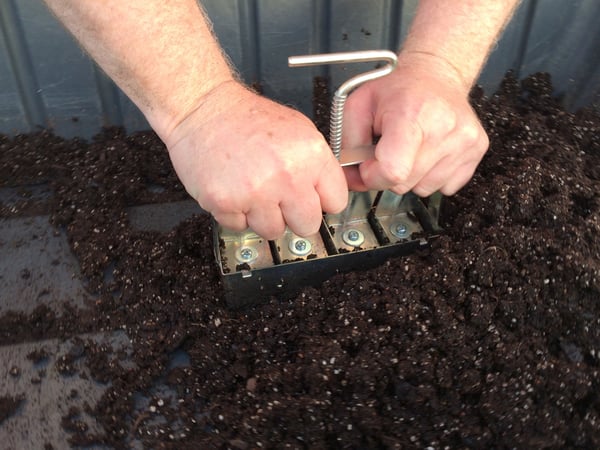
Firm pressure is needed to fully compact the soil into the block makers.
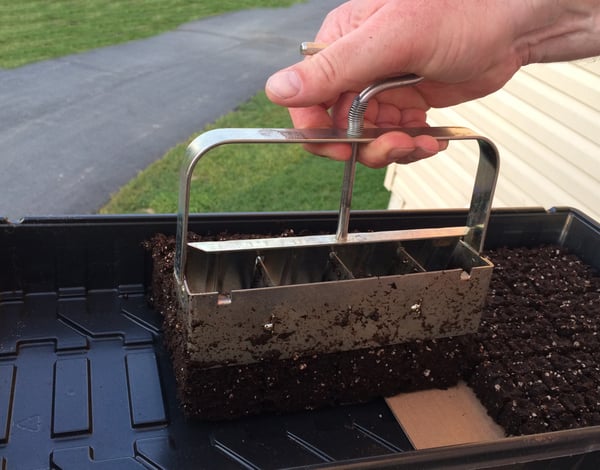
Press the handle while lifting the block maker to release the fully formed soil block.
In my experimentation with making soil blocks using Fertrell Premium Potting Soil, my ¾” and 2” blocks turned out great. My 4” soil blocks did not hold their shape very well, you can see they are crumbling in the photo. I think that I over moistened the batch of soil I used for that size block. When making your blocks, you should be prepared for some experimentation with the amount of water required to create blocks in each size.
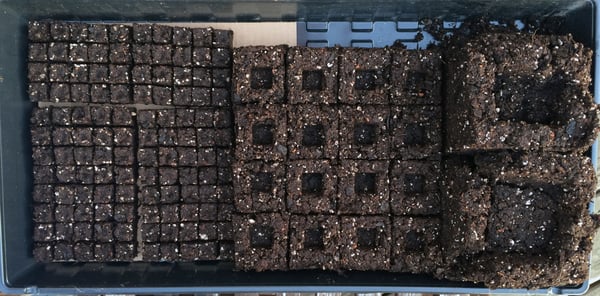
Finished soil blocks in various sizes.
Fertrell’s Premium Potting Soil will provide your seedlings with all the nutrients required to reach a transplantable size and is a convenient, cost effective material for making soil blocks to start seeds. If you try soil blocking this season, share your results and photos with me at dean@fertrell.com.
